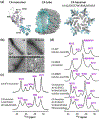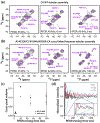Fast Magic-Angle Spinning 19 F NMR Spectroscopy of HIV-1 Capsid Protein Assemblies
- PMID: 30225969
- PMCID: PMC6279522
- DOI: 10.1002/anie.201809060
Fast Magic-Angle Spinning 19 F NMR Spectroscopy of HIV-1 Capsid Protein Assemblies
Abstract
19 F NMR spectroscopy is an attractive and growing area of research with broad applications in biochemistry, chemical biology, medicinal chemistry, and materials science. We have explored fast magic angle spinning (MAS) 19 F solid-state NMR spectroscopy in assemblies of HIV-1 capsid protein. Tryptophan residues with fluorine substitution at the 5-position of the indole ring were used as the reporters. The 19 F chemical shifts for the five tryptophan residues are distinct, reflecting differences in their local environment. Spin-diffusion and radio-frequency-driven-recoupling experiments were performed at MAS frequencies of 35 kHz and 40-60 kHz, respectively. Fast MAS frequencies of 40-60 kHz are essential for consistently establishing 19 F-19 F correlations, yielding interatomic distances of the order of 20 Å. Our results demonstrate the potential of fast MAS 19 F NMR spectroscopy for structural analysis in large biological assemblies.
Keywords: 19F NMR spectroscopy; capsids; magic angle spinning; protein assemblies; protein structures.
© 2018 Wiley-VCH Verlag GmbH & Co. KGaA, Weinheim.
Figures



Similar articles
-
19F Dynamic Nuclear Polarization at Fast Magic Angle Spinning for NMR of HIV-1 Capsid Protein Assemblies.J Am Chem Soc. 2019 Apr 10;141(14):5681-5691. doi: 10.1021/jacs.8b09216. Epub 2019 Apr 1. J Am Chem Soc. 2019. PMID: 30871317 Free PMC article.
-
Combined zero-quantum and spin-diffusion mixing for efficient homonuclear correlation spectroscopy under fast MAS: broadband recoupling and detection of long-range correlations.J Biomol NMR. 2015 Jan;61(1):7-20. doi: 10.1007/s10858-014-9875-6. Epub 2014 Nov 25. J Biomol NMR. 2015. PMID: 25420598 Free PMC article.
-
Magic angle spinning NMR reveals sequence-dependent structural plasticity, dynamics, and the spacer peptide 1 conformation in HIV-1 capsid protein assemblies.J Am Chem Soc. 2013 Nov 27;135(47):17793-803. doi: 10.1021/ja406907h. Epub 2013 Nov 13. J Am Chem Soc. 2013. PMID: 24164646 Free PMC article.
-
Probing structure and dynamics of protein assemblies by magic angle spinning NMR spectroscopy.Acc Chem Res. 2013 Sep 17;46(9):2047-58. doi: 10.1021/ar300309s. Epub 2013 Feb 13. Acc Chem Res. 2013. PMID: 23402263 Free PMC article. Review.
-
DNP NMR of biomolecular assemblies.J Struct Biol. 2019 Apr 1;206(1):90-98. doi: 10.1016/j.jsb.2018.09.011. Epub 2018 Sep 29. J Struct Biol. 2019. PMID: 30273657 Review.
Cited by
-
The precious fluorine on the ring: fluorine NMR for biological systems.J Biomol NMR. 2020 Sep;74(8-9):365-379. doi: 10.1007/s10858-020-00331-z. Epub 2020 Jul 10. J Biomol NMR. 2020. PMID: 32651751 Free PMC article.
-
Determination of accurate 19F chemical shift tensors with R-symmetry recoupling at high MAS frequencies (60-100 kHz).J Magn Reson. 2022 Jul;340:107227. doi: 10.1016/j.jmr.2022.107227. Epub 2022 Apr 26. J Magn Reson. 2022. PMID: 35568013 Free PMC article.
-
Small, but powerful and attractive: 19F in biomolecular NMR.Structure. 2022 Jan 6;30(1):6-14. doi: 10.1016/j.str.2021.09.009. Epub 2021 Dec 13. Structure. 2022. PMID: 34995480 Free PMC article. Review.
-
Cholesterol-Mediated Clustering of the HIV Fusion Protein gp41 in Lipid Bilayers.J Mol Biol. 2022 Jan 30;434(2):167345. doi: 10.1016/j.jmb.2021.167345. Epub 2021 Nov 8. J Mol Biol. 2022. PMID: 34762895 Free PMC article.
-
19F Dynamic Nuclear Polarization at Fast Magic Angle Spinning for NMR of HIV-1 Capsid Protein Assemblies.J Am Chem Soc. 2019 Apr 10;141(14):5681-5691. doi: 10.1021/jacs.8b09216. Epub 2019 Apr 1. J Am Chem Soc. 2019. PMID: 30871317 Free PMC article.
References
Publication types
MeSH terms
Substances
Grants and funding
LinkOut - more resources
Full Text Sources
Other Literature Sources
Medical

